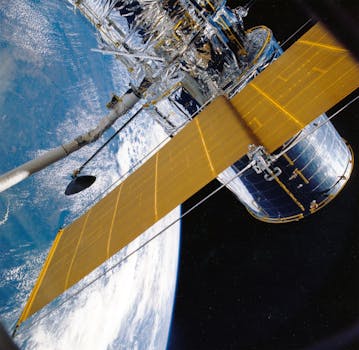
Beyond Earth: How Recent Advances in Satellite Tech are Shaping Global Communications
Beyond Earth: How Recent Advances in Satellite Tech are Shaping Global Communications. The advent of satellite technology has been a game-changer for global communications. With the ability to transmit data and signals through space, satellites have enabled connectivity across the globe, bridging the gap between remote and urban areas. Recent advances in satellite tech have further accelerated this trend, paving the way for faster, more reliable, and more efficient communication systems.
Advances in Satellite Technology
In recent years, there have been significant advancements in satellite technology, driven by innovations in materials, design, and manufacturing. One of the key developments has been the introduction of high-throughput satellites (HTS), which offer faster data transfer rates and greater bandwidth. HTS satellites use advanced technologies such as phased arrays and beamforming to focus signals on specific areas, increasing the efficiency of data transmission. This has enabled the widespread adoption of satellite-based broadband services, particularly in areas where terrestrial infrastructure is limited or non-existent.
Another significant advancement has been the development of low-Earth orbit (LEO) satellites. LEO satellites orbit the Earth at an altitude of around 2,000 kilometers, which is much lower than traditional geostationary satellites. This lower orbit enables faster data transfer rates and reduced latency, making LEO satellites ideal for real-time applications such as video conferencing and online gaming. Companies such as SpaceX and OneWeb are leading the charge in LEO satellite technology, with plans to launch thousands of satellites in the coming years.
Impact on Global Communications
The recent advances in satellite tech have had a profound impact on global communications. Satellite-based connectivity has enabled people in remote and underserved areas to access the internet, bridging the digital divide and fostering economic growth. Satellite communications have also played a critical role in disaster response and recovery, providing vital connectivity in areas where terrestrial infrastructure has been damaged or destroyed.
In addition, satellite tech has enabled the development of new applications and services, such as satellite-based navigation and Earth observation. Satellite navigation systems such as GPS and Galileo have revolutionized the way we navigate, while Earth observation satellites have enabled us to monitor the environment, track weather patterns, and predict natural disasters.
Challenges and Opportunities
Despite the many advances in satellite tech, there are still significant challenges to be addressed. One of the major challenges is the issue of space debris, which poses a significant threat to the long-term sustainability of satellite communications. Space debris refers to the accumulation of defunct satellites, rocket parts, and other objects in Earth’s orbit, which can collide with operational satellites and cause damage or destruction.
Another challenge is the need for greater standardization and interoperability in satellite systems. With the proliferation of different satellite constellations and technologies, there is a risk of fragmentation and incompatibility, which could hinder the development of seamless and efficient global communication systems.
However, these challenges also present opportunities for innovation and growth. The development of new technologies and systems to address the issue of space debris, such as satellite servicing and debris removal, could create new markets and opportunities for investment. Similarly, the push for standardization and interoperability could drive the development of new standards and protocols, enabling greater collaboration and cooperation between satellite operators and manufacturers.




